
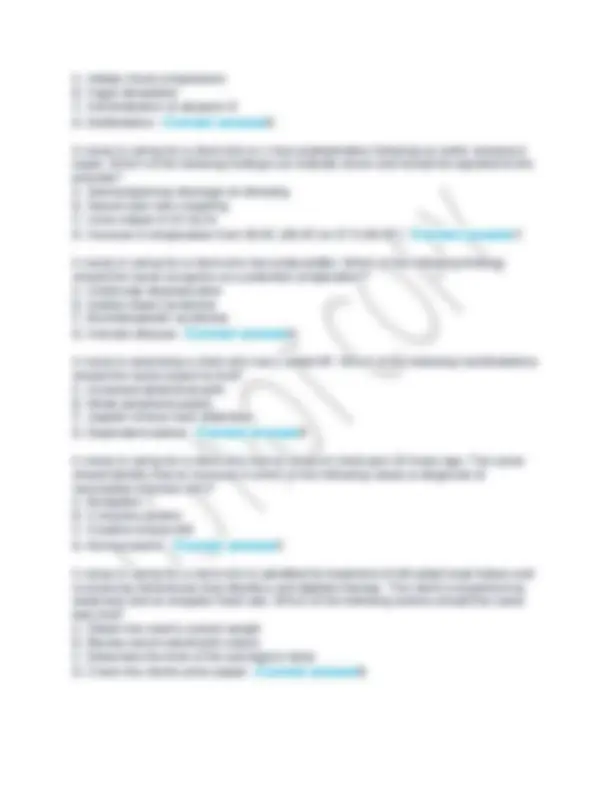
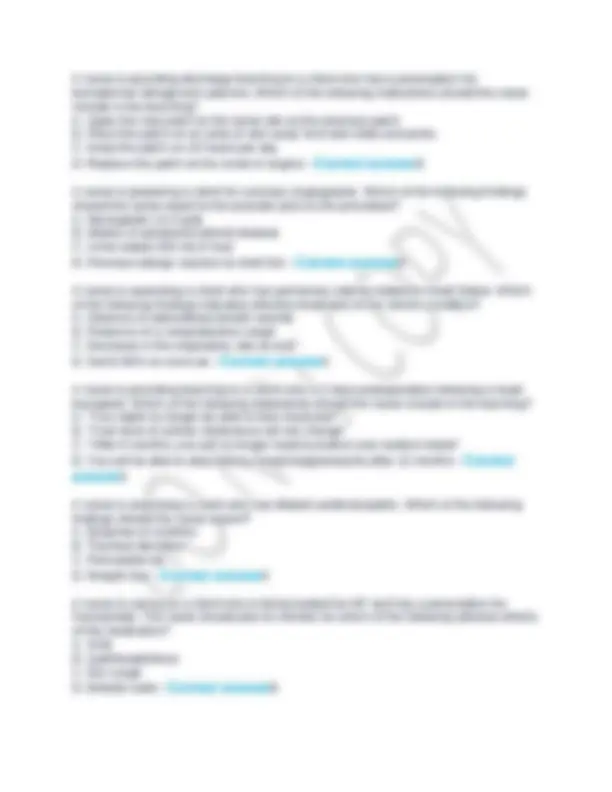

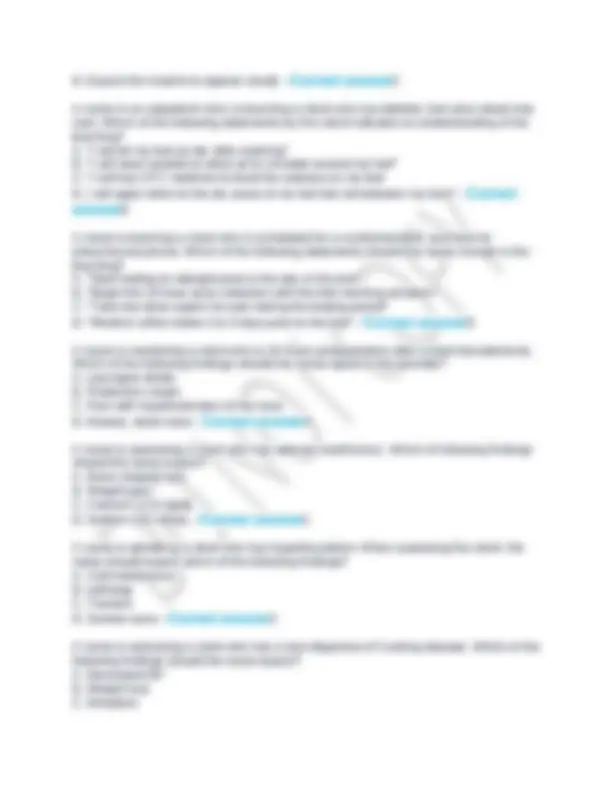
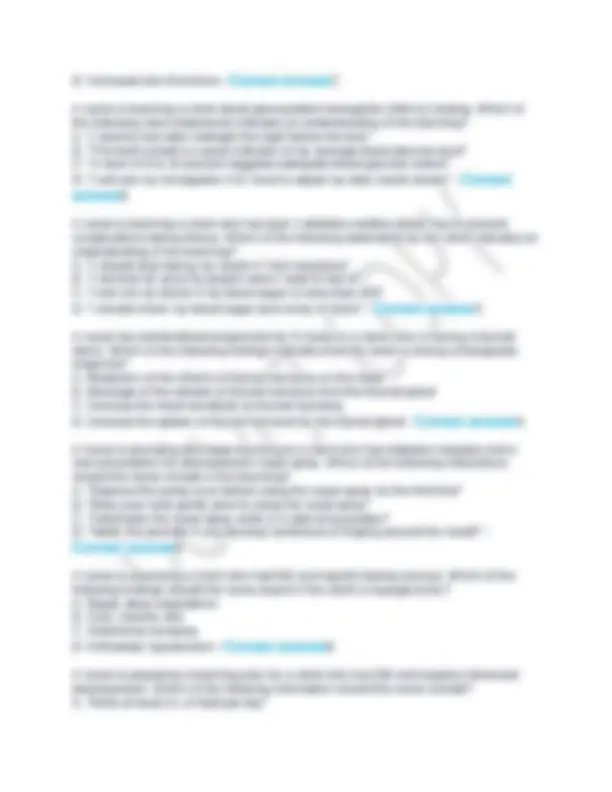
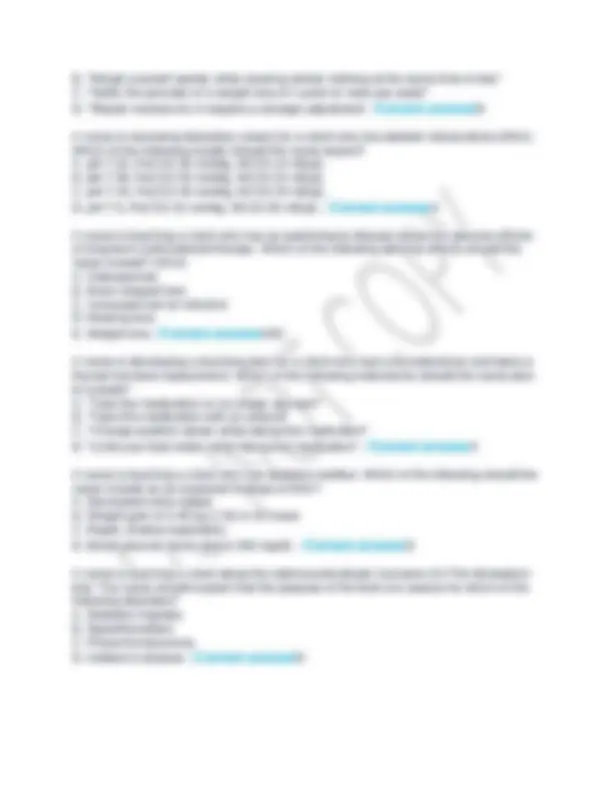
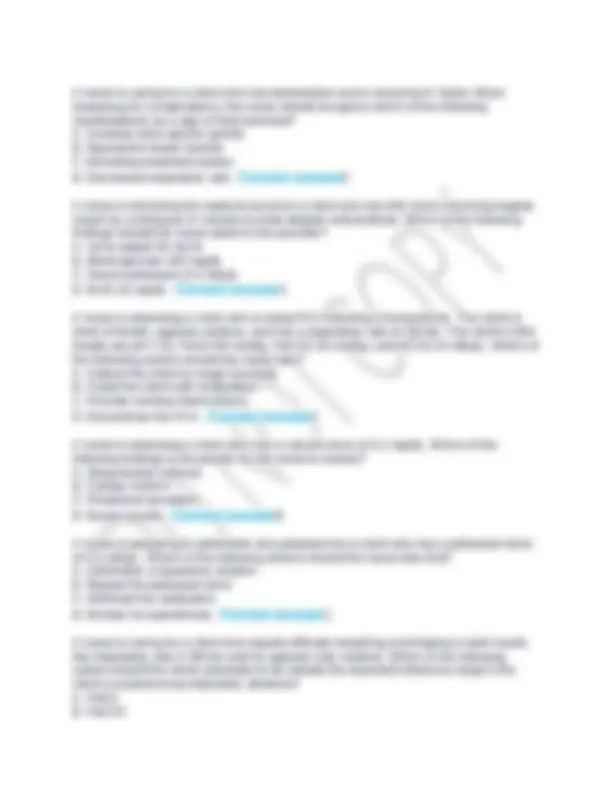
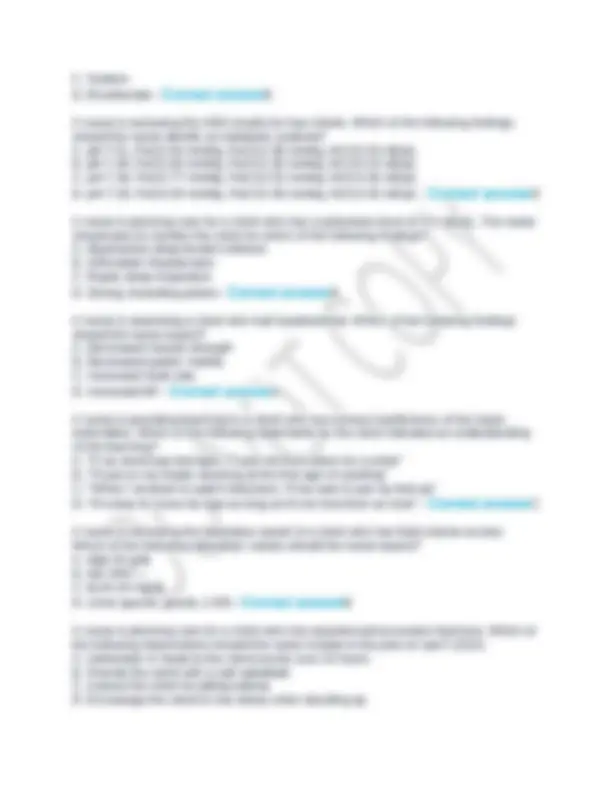
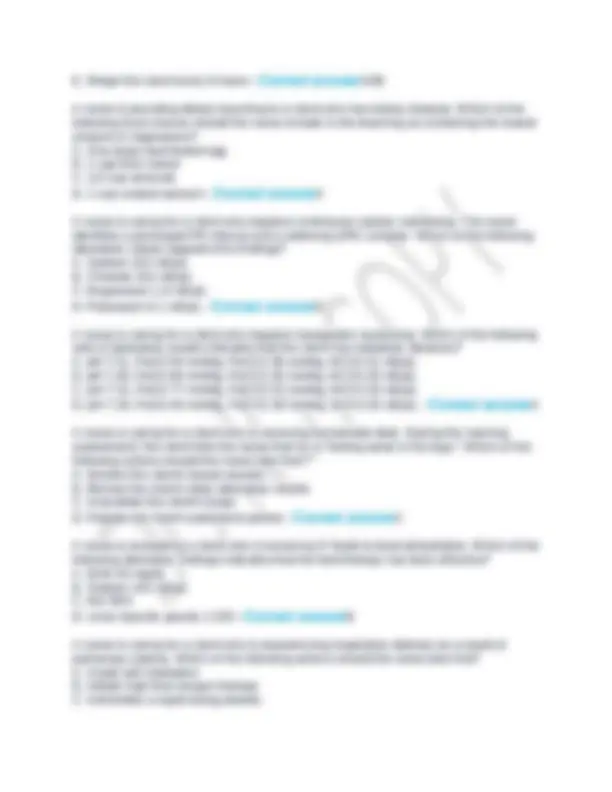
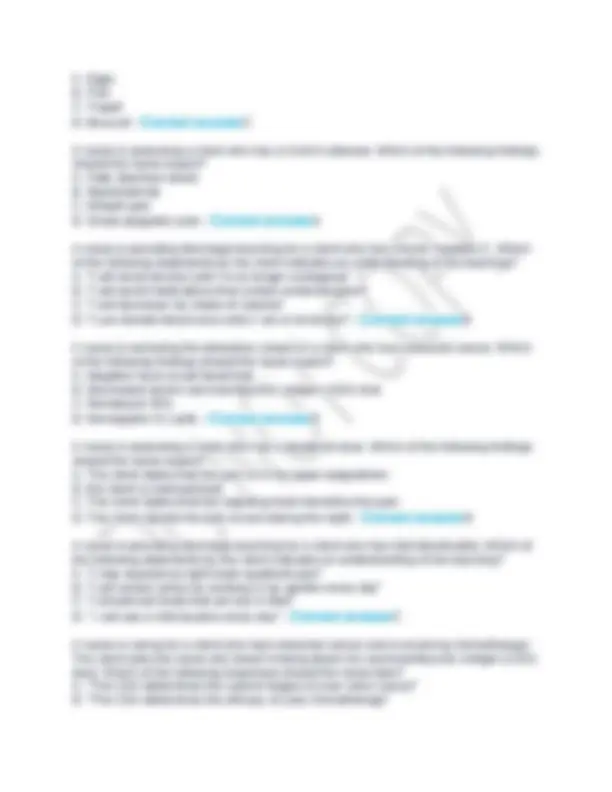

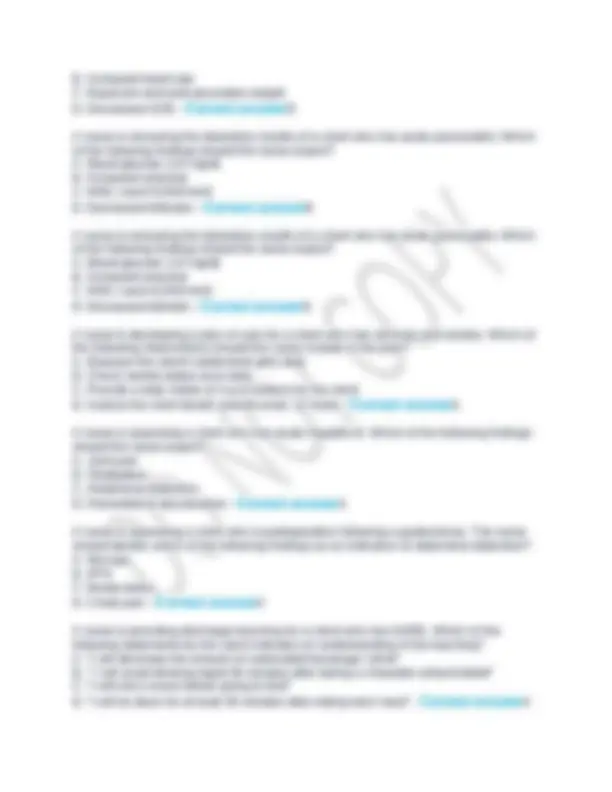
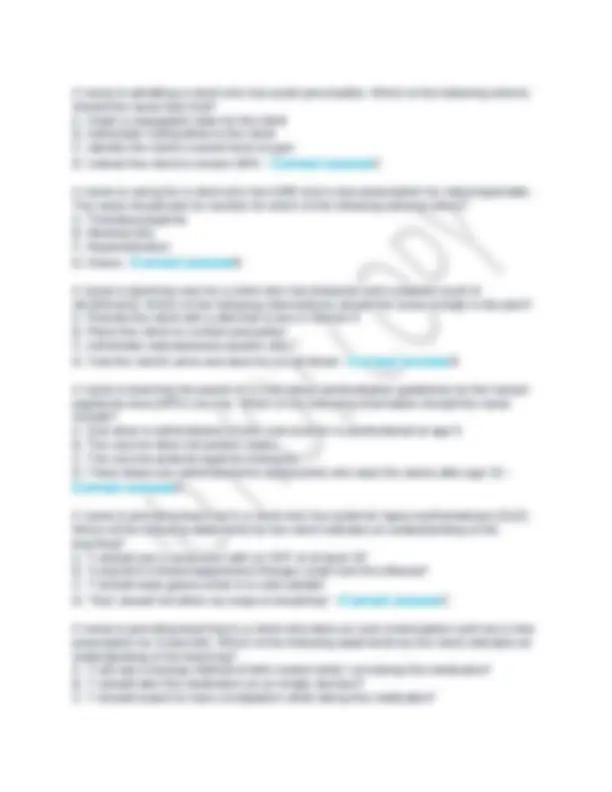
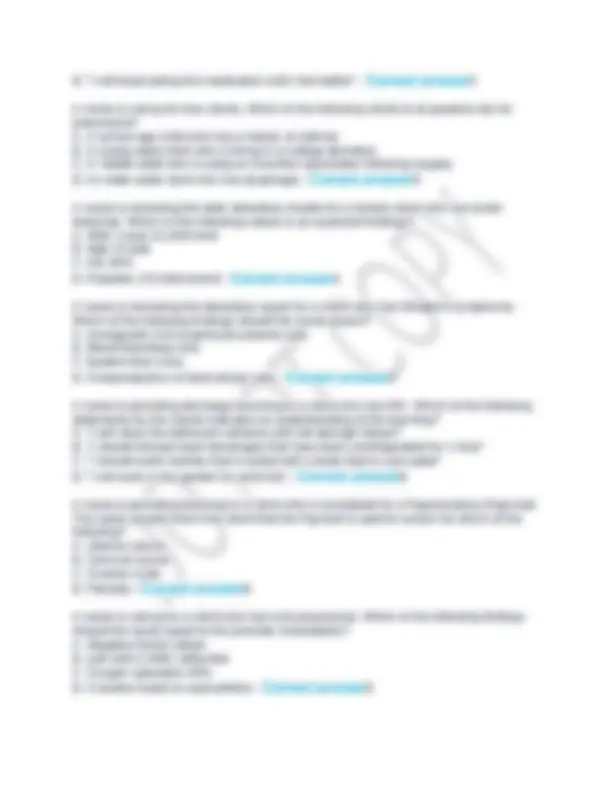
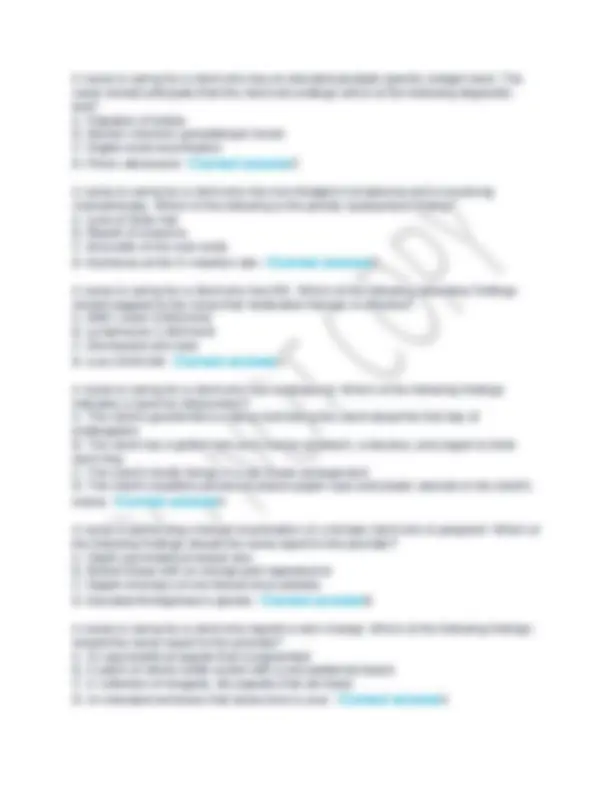
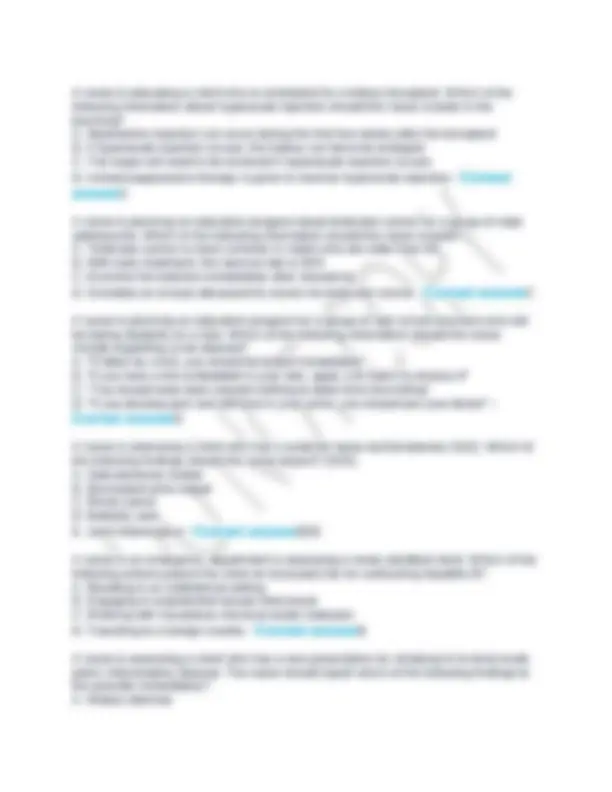
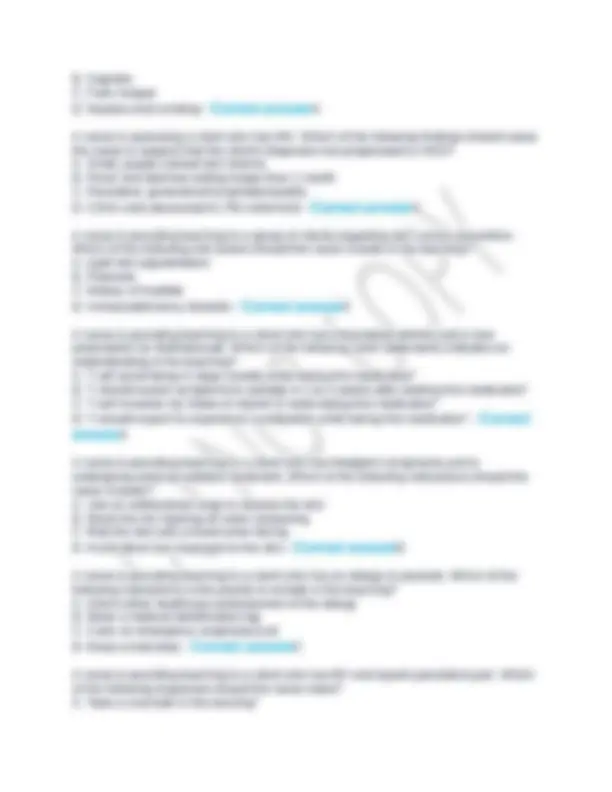
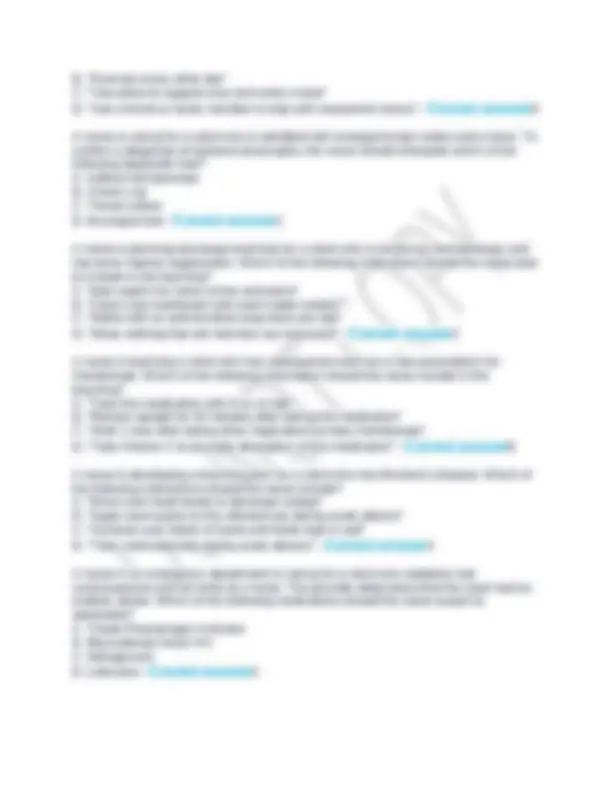
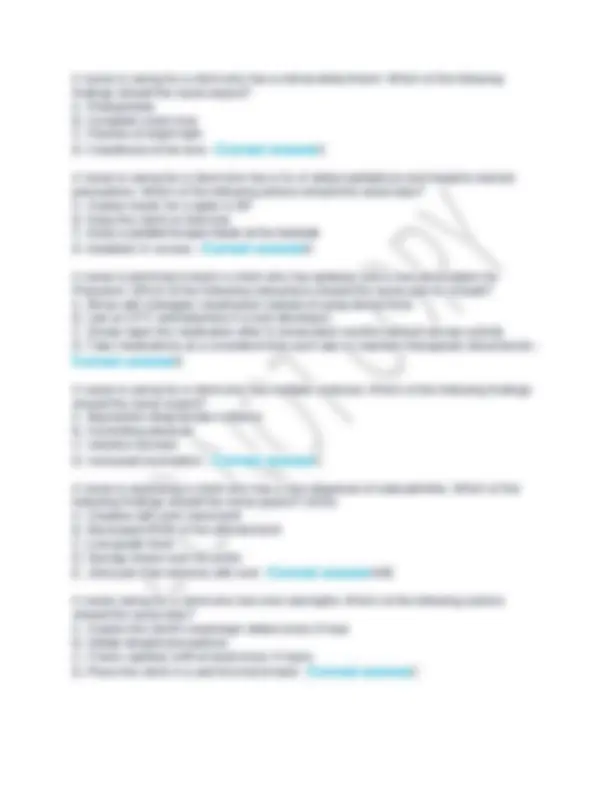
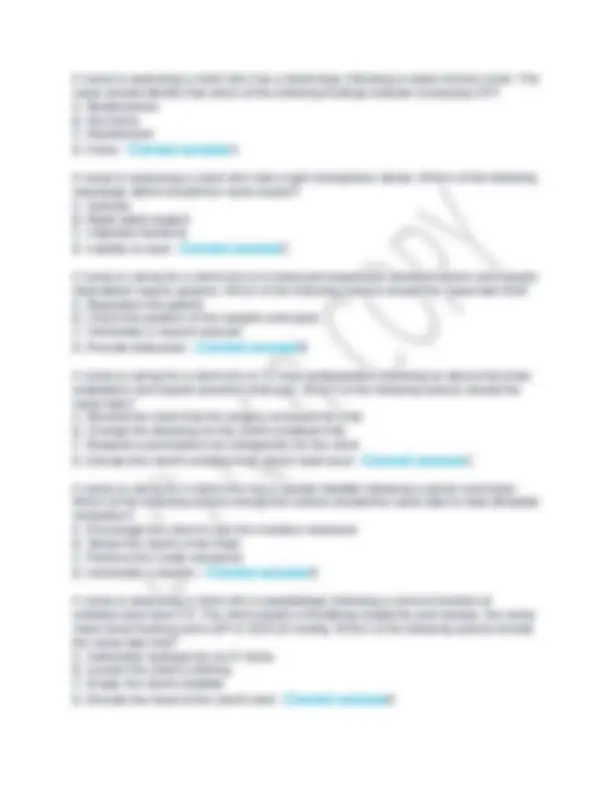
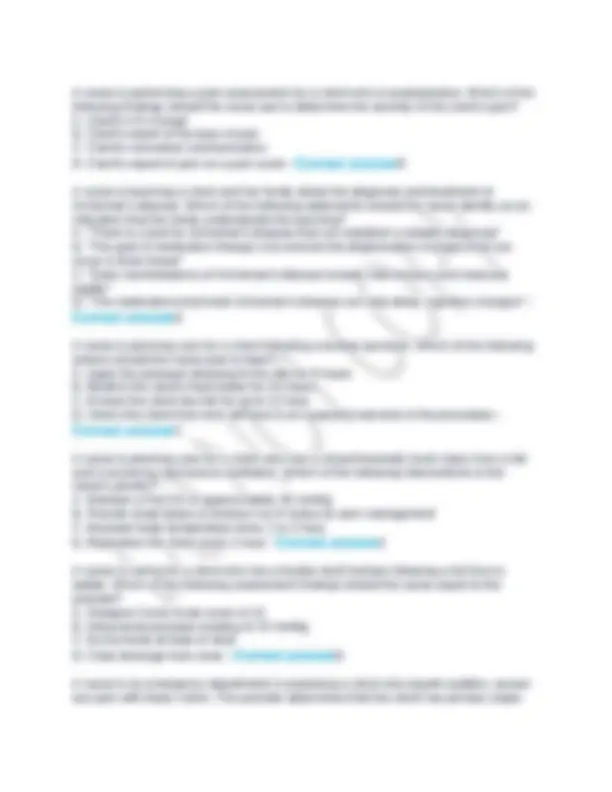
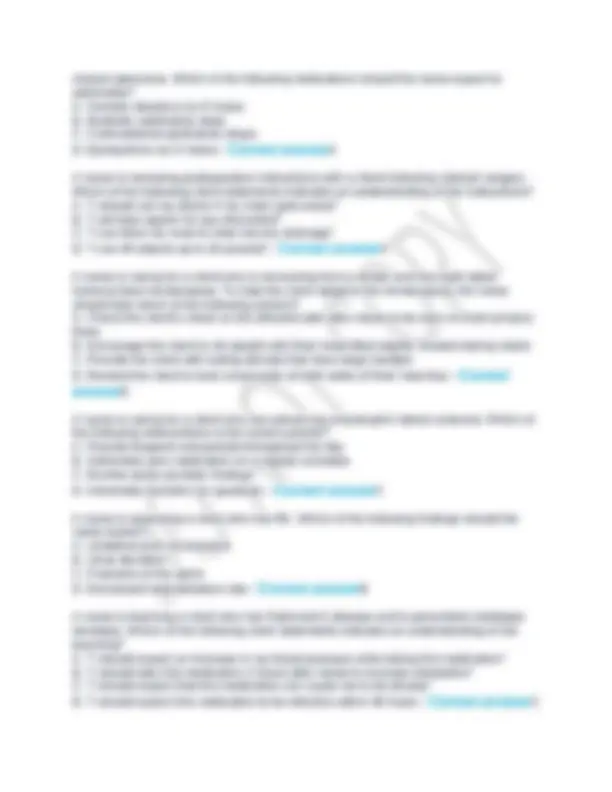
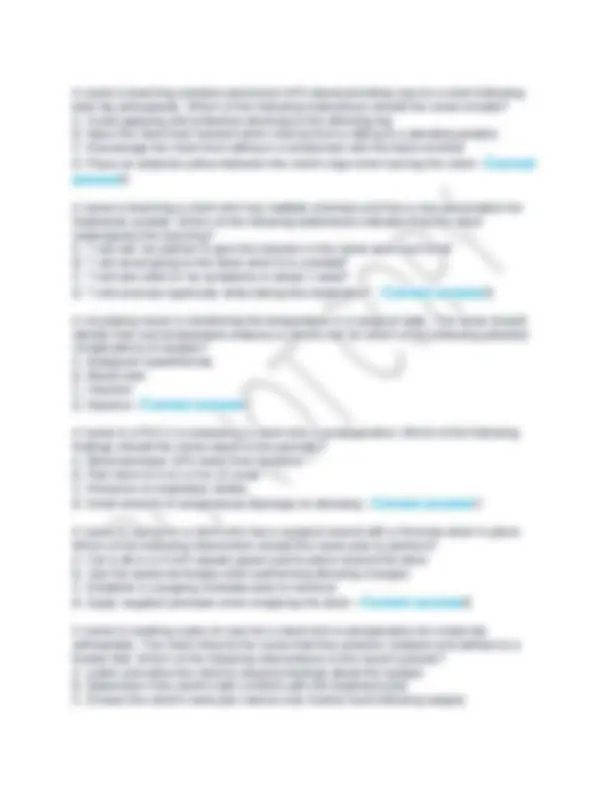
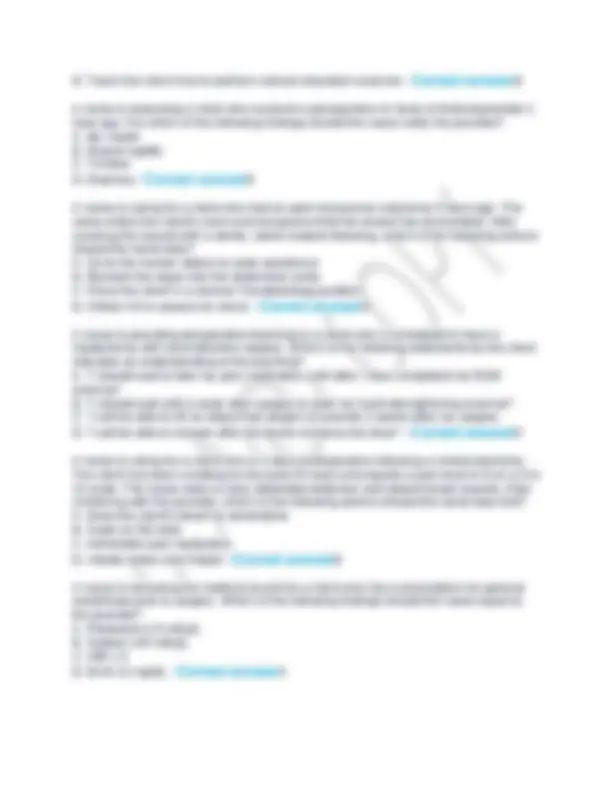
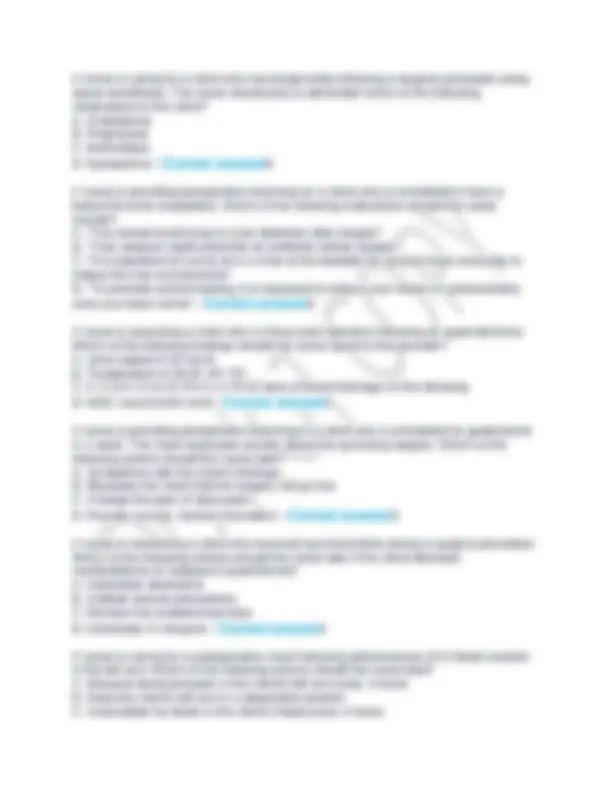
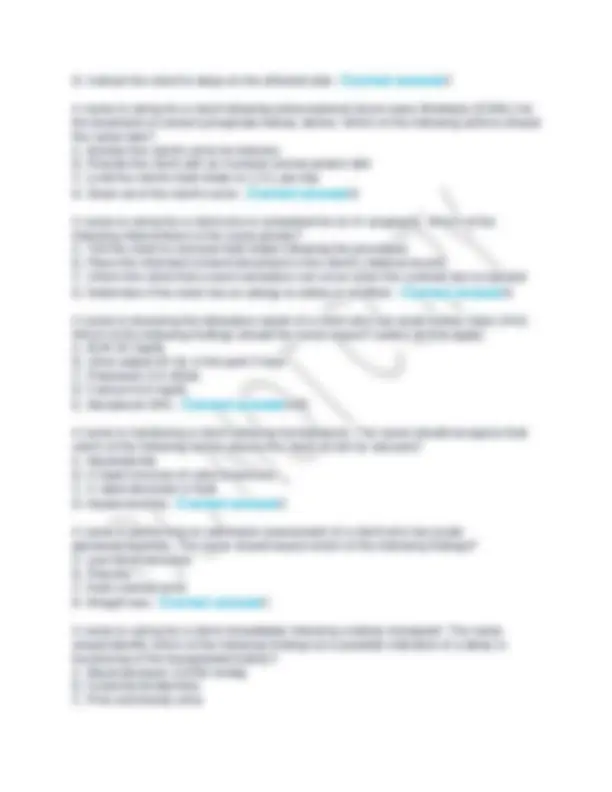
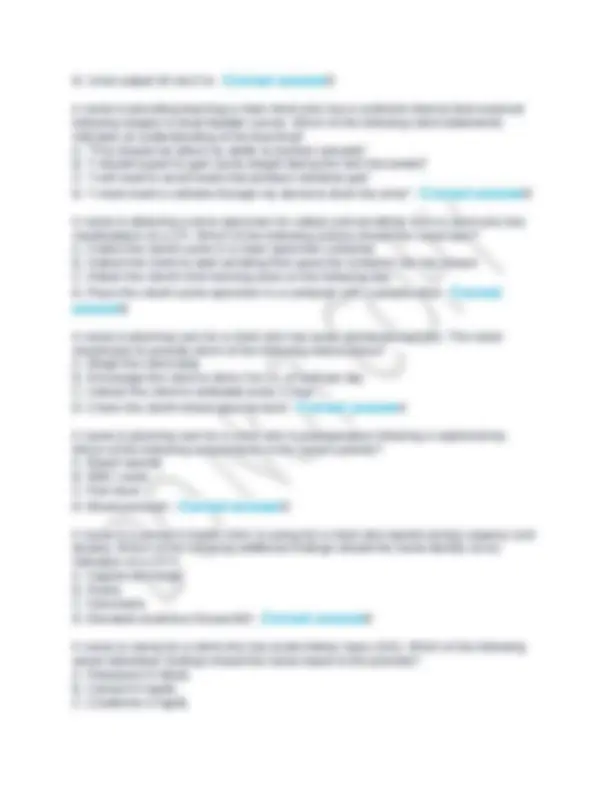
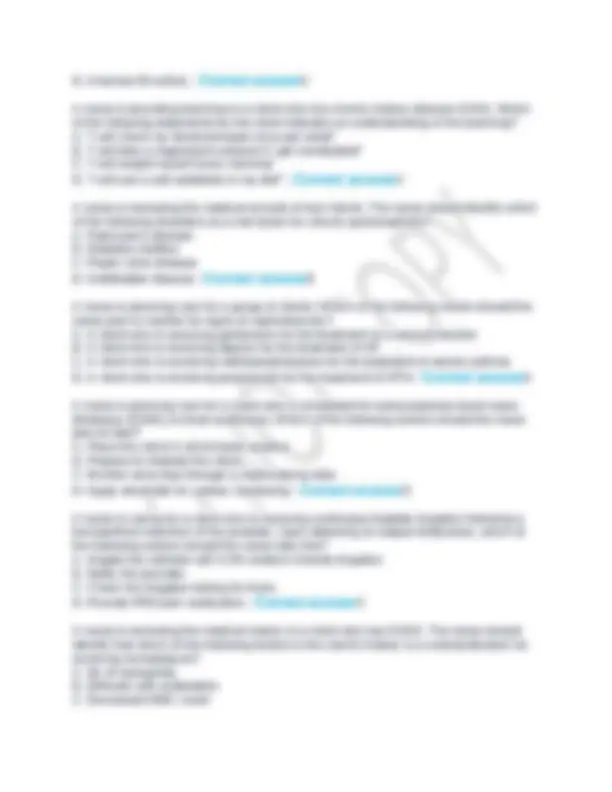
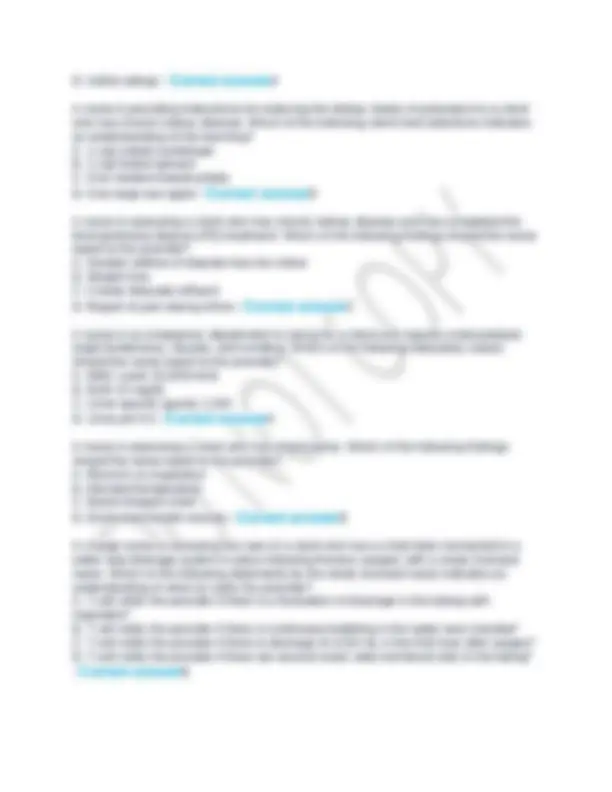
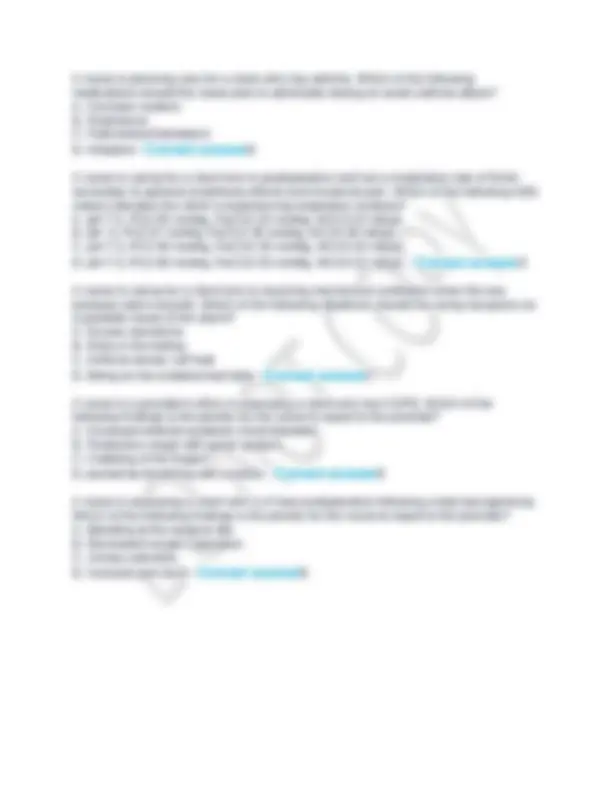


Study with the several resources on Docsity

Earn points by helping other students or get them with a premium plan


Prepare for your exams
Study with the several resources on Docsity

Earn points to download
Earn points by helping other students or get them with a premium plan
Community
Ask the community for help and clear up your study doubts
Discover the best universities in your country according to Docsity users
Free resources
Download our free guides on studying techniques, anxiety management strategies, and thesis advice from Docsity tutors
ATI MEDICAL SURGICAL RETAKE 2025- 2026 COMPLETE 220QUESTIONS AND CORRECT DETAILED ANSWERS (VERIFIED ANSWERS).ATI MEDICAL SURGICAL RETAKE 2025- 2026 COMPLETE 220QUESTIONS AND CORRECT DETAILED ANSWERS (VERIFIED ANSWERS).
Typology: Exams
1 / 38

This page cannot be seen from the preview
Don't miss anything!































A nurse is caring for a client who has a history of angina and is scheduled for exercise electrocardiography at 1100. Which of the following statements by the client requires the nurse to contact the provider for possible rescheduling? A. "I'm still hungry after the bowl of cereal I ate at 0700" B. "I didn't tale my heart pills this morning because the doctor told me not to" C. "I have had chest pain a couple of time since I saw my doctor in the office last week" D. "I smoked a cigarette this morning to calm my nerves about having this procedure" -
A nurse is providing discharge teaching to a client who has heart failure. The nurse should instruct the client to report which of the following findings immediately to the provider? A. Weight gain of 0.9 kg (2 lb) in 24 hours) B. Increase of 10 mmHg in systolic blood pressure C. Dyspnea with exertion
A nurse is assessing a client who has history a deep-vein thrombosis and is receiving Warfarin. Which of the following findings should indicate to the nurse that the medication is effective? A. Hemoglobin 14 g/dL B. Minimal bruising of extremities C. Decreased bp
A nurse is caring for a client who is receiving heparin therapy and develops hematuria. Which of the following actions should the nurse take if the client's aPTT is 96 seconds. A. increase the heparin infusion flow rate by 2 mL/hr B. Continue to monitor the heparin infusion as prescribed C. Request a prothrombin time (PT)
A nurse is caring for a client who has heart failure and is experiencing atrial fibrillation. Which of the following findings should the nurse plan to monitor for and report to the provider immediately? A. Slurred speech B. Irregular pulse
C. Dependent edema
A nurse is reviewing the laboratory results of several male clients who have peripheral arterial disease. The nurse should plan to provide dietary teaching for the client who has which of the following laboratory value? A. Cholesterol 180 mg/dL, HDL 70 mg/dL, LDL 90 mg/dL B. Cholesterol 185 mg/dL, HDL 50 mg/dL, LDL 120 mg/dL C. Cholesterol 190 mg/dL, HDL 25 mg/dL, LDL 160 mg/dL
A nurse in an emergency department is assessing a client who has bradydysrhythmia. Which of the following findings should the nurse monitor for? A. Confusion B. Friction rub C. Hypertension
A nurse is caring for a client following the insertion of a permanent pacemaker. Which of the following client statement indicates a potential complication of the insertion procedure? A. "I can't get rid of these hiccups" B. "I feel dizzy when I stand" C. "My incision site stings"
A nurse is planning a presentation for a group of clients who have HTN. Which of the following lifestyle modification should the nurse include? A. Limited alcohol intake B. Regular exercise program C. Decreased magnesium intake D. Reduced potassium intake
A nurse is providing health teaching to a group of clients. Which of the following clients is at risk for developing peripheral arterial disease? A. A client who has hypothyroidism B. A client who has diabetes mellitus C. A client whose daily caloric intake consists of 25% fat
A nurse is monitoring a client's ECG monitor and notes the client's rhythm has changed from normal sinus rhythm to SVT. The nurse should prepare to assist with which of the following interventions?
A nurse is providing discharge teaching to a client who has a prescription for transdermal nitroglycerin patches. Which of the following instructions should the nurse include in the teaching? A. Apply the new patch to the same site as the previous patch B. Place the patch on an area of skin away from skin folds and joints C. Keep the patch on 24 hours per day
A nurse is preparing a client for coronary angiography. Which of the following findings should the nurse report to the provider prior to the procedure? A. Hemoglobin 14.4 g/dL B. History of peripheral arterial disease C. Urine output 200 mL/4 hour
A nurse is assessing a client who has pulmonary edema related to heart failure. Which of the following findings indicates effective treatment of the client's condition? A. Absence of adventitious breath sounds B. Presence of a nonproductive cough C. Decrease in the respiratory rate at rest
A nurse is providing teaching to a client who is 2 days postoperative following a heart transplant. Which of the following statements should the nurse include in the teaching? A. "You might no longer be able to feel chest pain" B. "Your level of activity intolerance will not change" C. "After 6 months, you will no longer need to restrict your sodium intake"
A nurse is assessing a client who has dilated cardiomyopathy. Which of the following findings should the nurse expect? A. Dyspnea on exertion B. Tracheal deviation C. Pericardial rub
A nurse is caring for a client who is being treated for HF and has a prescription for Furosemide. The nurse should plan to monitor for which of the following adverse effects of the medication? A. SOB B. Lightheadedness C. Dry cough
A nurse is caring for a client who is 8 hour postoperative following a coronary artery bypass graft (CABG). Which of the following findings should the nurse report? A. Mediastinal drainage 100 mL/hr B. Blood pressure 160/80 mmHg C. Temperature 37.1C (98.8F)
A nurse is admitting who has a leg ulcer and history of DM. Which of the following focused assessments should the nurse use to help differentiate between an arterial ulcer and a venous Stasis ulcer? A. Explore the client's family history of PAD B. Note the presence or absence of pain at the ulcer site C. Inquire about the presence or absence of claudication
A nurse is caring for a client who is scheduled for a coronary artery bypass graft (CABG) in 2 hour. Which of the following client statements indicates a need for further clarification by the nurse? A. "My arthritis is really bothering me b/c I haven't taken my aspirin in a week" B. "My bp presssure shouldn't be high because I took my BP meds this morning" C. "I took my warfarin last night according to my usual schedule" D. "I will check my blood sugar b/c i took a reduced dose of insulin this morning" -
A nurse in a emergency department is caring for a client who has a bp of 254/ mmHg. The nurse recognize that the client is in a hypertensive crisis. Which of the following actions should the nurse take first? A. Initiate seizure precautions B. Tell the client to report vision changes C. Elevate the head of the client bed
A nurse in an emergency department is caring for a client who had an anterior myocardial infarction. The client's hx reveal they are 1 wk postoperative following an open cholecystectomy. The nurse should identify that which of the following interventions is contraindicated? A. Administering IV morphine Sulfate B. Administering O2 at 2L/min via nasal cannula C. Helping the client to the beside commode
A nurse is teaching a client who has a new prescription for an ACE inhibitor to treat HTN. The nurse should instruct the client to notify their provider if they experience which of the following adverse effect of this medication? A. Tendon pain B. Persistent cough
A nurse is caring for a client who has diabetes mellitus and has developed peripheral neuropathy. Which of the following measures should the nurse recommend to prevent injuries to the client's feet? A. Examine the skin of the feet weekly for alterations in skin integrity B. Monitor the temperature of bath water with a thermometer C. Shop for shoes early in the day
A nurse is planning teaching for a client who has type 1 diabetes mellitus? Which of the following instruction should the nurse plan to include? A. Consume no more than 3 servings of alcohol per day B. Ingest food with alcohol to reduce alcohol-induced hypoglycemia C. Increased insulin dosage before planned exercise
A nurse is managing the care of a client who is postoperative and has acute adrenal insufficiency. Which of the following actions should the nurse take? A. Administer IV hydrocortisone sodium B. Give oral spironolactone C. Infuse 1 unit of platelets
A nurse is caring for a client who has type 2 diabetes mellitus and is experiencing a hyperglycemic hyperosmolar state (HHS). Which of the following laboratory findings should the nurse expect? A. Serum pH 7. B. Blood glucose 250 mg/dL C. Blood glucose 425 mg/dL
A nurse is reviewing the laboratory results of a client undergoing screening for primary Cushing's disease. The nurse should expect an elevation in which of the following laboratory findings? A. Lymphocyte count B. Potassium C. Calcium
A nurse is teaching a client who has diabetes mellitus about insulin injections. The client's prescription includes evening doses of insulin glargine and regular insulin. Which of the following instructions should the nurse include? A. Inject the insulin intramuscularly B. Shake the insulin vigorously prior to administration C. Draw up the insulin into separate syringes
A nurse in an outpatient clinic is teaching a client who has diabetic foot ulcer about foot care. Which of the following statements by the client indicates an understanding of the teaching? A. "I will let my feet air dry after washing" B. "I will wear sandals to allow air to circulate around my feet" C. "I will buy OTC medicine to treat the calluses on my feet
A nurse is teaching a client who is scheduled for a vanillylmandelic acid test for pheochromocytoma. Which of the following statements should the nurse include in the teaching? A. "Start fasting at midnight prior to the day of the test" B. "Begin the 24-hour urine collection with the first morning urination" C. "Take low-dose aspirin for pain during the testing period"
A nurse is monitoring a client who is 24 hours postoperative after a total thyroidectomy. Which of the following findings should the nurse report to the provider? A. Laryngeal stridor B. Productive cough C. Pain with hyperextension of the neck
A nurse is assessing a client who has adrenal insufficiency. Which of following findings should the nurse expect? A. Moon-shaped face B. Weight gain C. Calcium 12.8 mg/dL
A nurse is admitting a client who has hyperthyroidism. When assessing the client. the nurse should expect which of the following findings? A. Cold intolerance B. Lethargy C. Tremors
A nurse is assessing a client who has a new diagnosis of Cushing disease. Which of the following findings should the nurse expect? A. Decreased BP B. Weight loss C. Hirsutism
B. "Weigh yourself weekly while wearing similar clothing at the same time of day" C. "Notify the provider of a weight loss of 1 point or more per week"
A nurse is reviewing laboratory values for a client who has diabetic ketoacidosis (DKA). Which of the following results should the nurse expect? A. pH 7.32, PaCO2 36 mmHg, HCO3 14 mEq/L B. pH 7.38, PaCO2 55 mmHg, HCO3 22 mEq/L C. pH 7.44, PaCO2 40 mmHg, HCO3 24 mEq/L
A nurse is teaching a client who has an autoimmune disease about the adverse effects of long-term corticosteroid therapy. Which of the following adverse effects should the nurse include? (SOA) A. Osteoporosis B. Moon-shaped face C. Increased risk for infection D. Hearing loss
A nurse is developing a teaching plan for a client who had a thyroidectomy and takes a thyroid hormone replacement. Which of the following instructions should the nurse plan to include? A. "Take the medication on an empty stomach" B. "Take this medication with an antacid" C. "Change position slowly while taking this medication"
A nurse is teaching a client who has diabetes mellitus. Which of the following should the nurse include as an expected findings of DKA? A. Decreased urine output B. Weight gain of 0.45 kg (1 lb) in 24 hours C. Rapid, shallow respiration
A nurse is teaching a client about the adrenocorticotropic hormone (ACTH) stimulation test. The nurse should explain that the purpose of the test is to assess for which of the following disorders? A. Diabetes Inspidus B. Hyperthyroidism C. Pheochromocytoma
A home health nurse is assessing a client who requires lifelong hormone replacement therapy for the treatment of hypothyroidism. The client has not been taking the medication regularly. Which of the following findings should the nurse expect? A. Increased urine output B. Persistent diarrhea C. Tachycardia
While reviewing a client's laboratory results, a nurse notes a serum calcium level of 8. mg/dL. Which of the following actions should the nurse take? A. Implement seizure precaution B. Administer phosphate C. Initiate diuretic therapy
A nurse is providing teaching to a client who is at risk for developing respiratory acidosis following surgery. Which of the following statements by the client indicates an understanding of the teaching? A. "I should conserve energy by limiting my physical activity B. "I will wait until my pain is at least 6 out of 10 before I use the PCA" C. "I will limit my daily fluid intake to 2 or 3 glasses"
A nurse is assessing a client who has respiratory acidosis. Which of the following findings should the nurse expect? A. Confusion B. Peripheral edema C. Facial flushing and warmth
A nurse is teaching nutritional strategies to a client who has a low calcium level and an allergy to milk. Which of the following statement by the client indicates an understanding of the teaching? A. "I will eat more cheese because I can't drink milk" B. "I need to avoid food with vitamin D because I am allergic to milk" C. "I will stop taking my calcium supplements if they irritate my stomach"
A nurse is assessing a client who is receiving hydrochlorothiazide and notes that the client is confused and lethargic. Which of the following laboratory values should the nurse report to the provider? A. Sodium 128 mEq/L B. Potassium 4.8 mEq/L C. Calcium 9.1 mg/dL
A nurse is caring for a client who has dehydration and is receiving IV fluids. When assessing for complications, the nurse should recognize which of the following manifestations as a sign of fluid overload? A. Increase urine specific gravity B. Hypoactive bowel sounds C. Bounding peripheral pulses
A nurse is reviewing the medical record of a client who has DM and is receiving regular insulin by continuous IV infusion to treat diabetic ketoacidosis. Which of the following findings should the nurse report to the provider? A. Urine output 30 mL/hr B. Blood glucose 180 mg/dL C. Serum potassium 3.0 mEq/L
A nurse is assessing a client who is using PCA following a thoracotomy. The client is short of breath, appears restless, and has a respiratory rate of 28/min. The client's ABG results are pH 7.52, PaO2 89 mmHg, PaCO2 28 mmHg, and HCO3 24 mEq/L. Which of the following actions should the nurse take? A. Instruct the client to cough forcefully B. Assist the client with ambulation C. Provide calming interventions
A nurse is assessing a client who has a calcium level of 8.1 mg/dL. Which of the following findings is the priority for the nurse to assess? A. Deep-tendon reflexes B. Cardiac rhythm C. Peripheral sensation
A nurse is preparing to administer oral potassium to a client who has a potassium level of 5.5 mEq/L. Which of the following actions should the nurse take first? A. Administer a hypertonic solution B. Repeat the potassium level C. Withhold the medication
A nurse is caring for a client who reports difficulty breathing and tingling in both hands. His respiratory rate is 36/min and he appears very restless. Which of the following values should the nurse anticipate to be outside the expected reference range if the client is experiencing respiratory alkalosis? A. PaO B. PaCO
C. Sodium
A nurse is reviewing the ABG results for four clients. Which of the following findings should the nurse identify as metabolic acidosis? A. pH 7.51, PaO2 94 mmHg, PaCO2 38 mmHg, HCO3 29 mEq/L B. pH 7.48, PaO2 89 mmHg, PaCO2 30 mmHg, HCO3 24 mEq/L C. pH 7.36, PaO2 77 mmHg, PaCO2 52 mmHg, HCO3 26 mEq/L
A nurse is planning care for a client who has a potassium level of 3.0 mEq/L. The nurse should plan to monitor the client for which of the following findings? A. Hyperactive deep-tendon reflexes B. Orthostatic Hypotension C. Rapid, deep respiration
A nurse is assessing a client who had hyperkalemia. Which of the following findings should the nurse expect? A. Decreased muscle strength B. Decreased gastric motility C. Increased heart rate
A nurse is providing teaching to a client who has venous insufficiency of the lower extremities. Which of the following statements by the client indicates an understanding of the teaching? A. "If my stockings feel tight, I'll just roll them down for a while" B. "I'll put on my elastic stocking at the first sign of swelling" C. "When I sit down to watch television, I'll be sure to put my feet up"
A nurse is reviewing the laboratory report of a client who has fluid volume excess. Which of the following laboratory values should the nurse expect? A. Hgb 20 g/dL B. Hct 34% C. BUN 25 mg/dL
A nurse is planning care for a client who has experienced excessive fluid loss. Which of the following interventions should the nurse include in the plan of care? (SOA) A. Administer IV fluids to the client evenly over 24 hours B. Provide the client with a salt substitute C. Assess the client for pitting edema D. Encourage the client to rise slowly when standing up
A nurse is assessing a client who has hypomagnesemia. Which of the following findings should the nurse expect? A. Hyperactive deep tendon reflexes B. Increased bowel sounds C. Drowsiness
A nurse is teaching a client how to prepare for a colonoscopy. Which of the following instructions should the nurse include in the testing? A. "Refrain from eating or drinking for 2 hours prior to the procedure" B. "Stop taking aspirin the day before the procedure" C. "Drink clear liquids for 24 hours prior to the procedure, and then take nothing by mouth for 6 hour before the procedure" D. "Drink the oral liquid preparation for bowel cleansing slowly the night before the
A nurse is assessing a client who has appendicitis. Which of the following findings should the nurse expect? (SOA) A. Oral temperature 38.4 C (101.1F) B. WBC count 6,000/mm C. Bloody diarrhea D. Nausea and vomiting
A nurse is providing dietary teaching for a client who is postoperative following a gastrectomy. Which of the following foods should the nurse encourage the client to include in their diet to reduce the risk for dumping syndrome? A. Ice cream B. Egg C. Grape juice
A nurse is providing discharge teaching for a client following an ileostomy. The nurse should instruct the client to report which of the following findings to the provider? A. Intolerance to high-fiber foods B. Liquid ileostomy output C. Dark purple stoma
A nurse is providing dietary teaching for a client who has a new diagnosis of celiac disease. Which of the following statements by the client indicates an understanding of the teaching? A. "I can return to regular diet when I am free of symptoms"
B. "I will need to avoid taking vitamin supplements while on this diet" C. "I will eat beans to ensure I get enough fiber in my diet"
A nurse is assessing a client who has cirrhosis. Which of the following findings is the priority for the nurse to report to the provider? A. Spider angiomas B. Peripheral edema C. Bloody stools
A nurse is assessing a client who has peritonitis. Which of the following findings should the nurse expect? A. Bloody diarrhea B. Board-like abdomen C. Periumbilical cyanosis
A nurse is providing teaching for a client who has cirrhosis and a new prescription for lactulose. The nurse should include which of the following instructions in the teaching? A. Notify the provider if bloating occurs B. Expect to have two to three soft stools per day C. Restrict carbohydrates in the diet
A nurse is assessing a client who has upper gastrointestinal bleeding. Which of the following findings should the nurse expect? A. Bradycardia B. Bounding peripheral pulses C. Hypotension
A nurse is caring for a client who has ulcerative colitis. The client has had several exacerbations over the past 3 years. Which of the following instructions should the nurse include in the plan of care to minimize the risk of further exacerbations? (SOA) A. Use progressive relaxation techniques B. Increase dietary fiber intake C. Drink 2 240mL (8 oz) glasses of milk per day) D. Arrange activities to allow for daily rest periods
A nurse is providing discharge teaching for a client who has a new colostomy and is concerned about flatus and odor. Which of the following foods should the nurse recommend to the client?
C. "The CEA determines if the neutrophils count is below the expected reference range" D. "The CEA determines if you are experiencing occult bleeding from the GI tract" -
A nurse is reviewing the prescription for a client who has Campylobacter enteritis. Which of the following prescriptions should the nurse clarify with the provider? A. 0.45% sodium chloride IV B. Magnesium hydroxide C. Ciprofloxacin
A nurse is providing discharge teaching for a client who has a new prescription for medications to treat peptic ulcer disease? The nurse should inform the client that which of the following medications inhibits gastric acid secretion? A. Calcium carbonate B. Famotidine C. Aluminum hydroxide
A nurse is providing discharge teaching for a client who has peptic ulcer disease and a new prescription for famotidine. Which of the following statements by the client indicates an understanding of the teaching? A. "I should take this medication at bedtime" B. "I should expect this medication to discolor my stools" C. "I will drink iced tea with my meals and snacks" D. "I will monitor my blood glucose level regularly while taking this medication -
A nurse is providing dietary teaching for a client who has chronic pancreatitis. Which of the following food selection by the client indicates an understanding of the teaching? A. 8 oz (0.24 L) whole milk B. One slice of beef bologna C. 1 oz (28.3 g) cheddar
A nurse is reviewing the laboratory results of a client who has hepatic cirrhosis. Which of the following laboratory findings should the nurse report to the provider? A. Albumin 4.0 g/dL B. INR 1. C. Direct bilirubin 0.5 mg/dL
A nurse is assessing a client immediately following a paracentesis for the treatment of ascites. Which of the following findings indicates the procedure was effective? A. Presence of a fluid wave
B. Increased heart rate C. Equal pre-and post-procedure weight
A nurse is reviewing the laboratory results of a client who has acute pancreatitis. Which of the following findings should the nurse expect? A. Blood glucose 110 mg/dL B. Increased amylase C. WBC count 9,000/mm
A nurse is reviewing the laboratory results of a client who has acute pancreatitis. Which of the following findings should the nurse expect? A. Blood glucose 110 mg/dL B. Increased amylase C. WBC count 9,000/mm
A nurse is developing a plan of care for a client who has cirrhosis and ascites. Which of the following interventions should the nurse include in the plan? A. Measure the client's abdominal girth daily B. Check mental status once daily C. Provide a daily intake of 4 g of sodium for the client
A nurse is assessing a client who has acute hepatitis B. Which of the following findings should the nurse expect? A. Joint pain B. Obstipation C. Abdominal distention
A nurse is assessing a client who is postoperative following a gastrectomy. The nurse should identify which of the following findings as an indication of abdominal distention? A. Hiccups B. HTN C. Bradycardia
A nurse is providing discharge teaching for a client who has GERD. Which of the following statements by the client indicates an understanding of the teaching? A. "I will decrease the amount of carbonated beverage I drink" B. " I will avoid drinking liquid 30 minutes after taking a chewable antacid tablet" C. "I will eat a snack before going to bed"